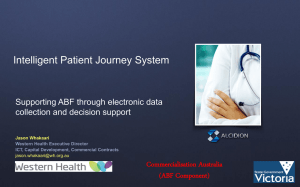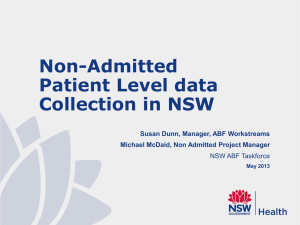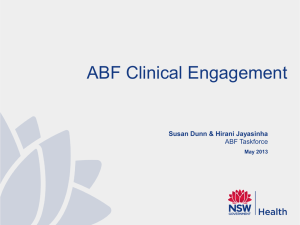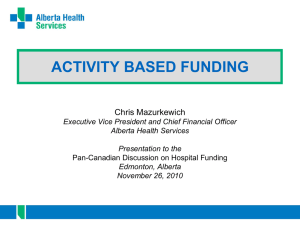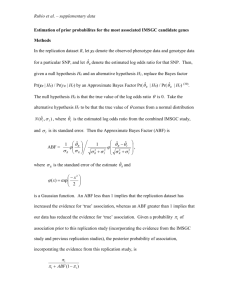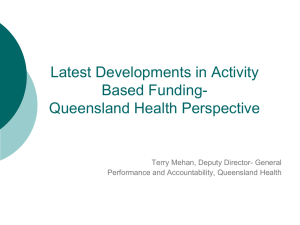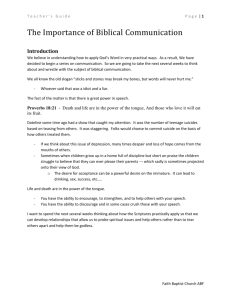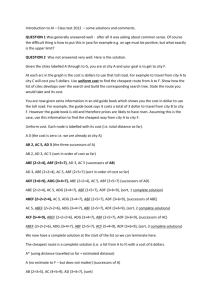Activity Based Funding Conference 2015 RCSI
advertisement
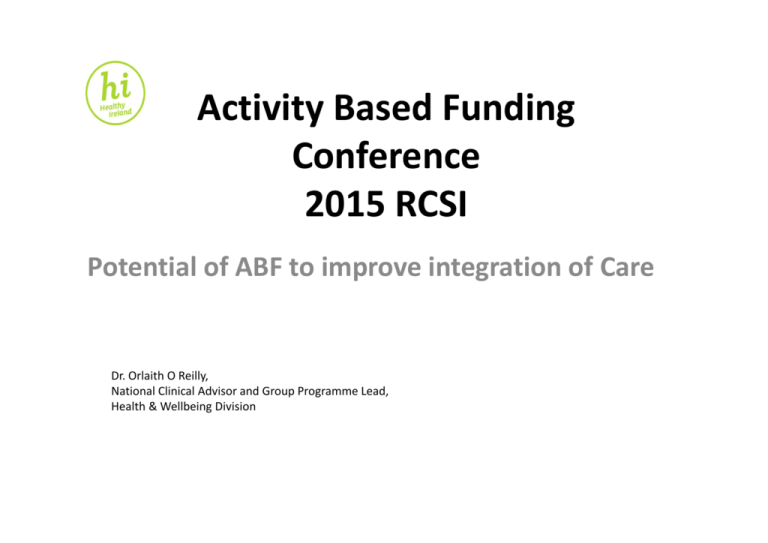
Activity Based Funding Conference 2015 RCSI Potential of ABF to improve integration of Care Dr. Orlaith O Reilly, National Clinical Advisor and Group Programme Lead, Health & Wellbeing Division Definitions • “Integrated Care is a continuum of preventive, diagnostic, treatment and support services for patients, appropriate to their needs, across different parts of the health system”. • Integrated Care is the full spectrum of care. • Integrated = joined up. • HIPE data records conditions that are significant in terms of treatment, investigation and cost. • ABF = payment based on activity. (what you do not who you are) • ABF is used internationally to incentivise behaviour. • HIPE and ABF are major systems the HSE resources, should be used to incentivise the way the system behaves for the benefit of patients. Health Service Challenges • Ageing population (85 years + increasing 4% PA). • Increased burden of chronic disease ( 20% – 40% by 2020). • Multiple chronic diseases. • Adverse trends in health determinants eg. obesity, poverty etc. • Unsustainable increase in cost of care. • Hospitals over run. • Need new way to deliver care; Integrated, at lowest level of complexity. Full Spectrum of Care Primary Prevention Acute Episodes Early Detection Chronic Disease Management Self Management Support Secondary Prevention Rehabilitation • Full spectrum of care currently takes place in all settings e.g. Hospital, Primary Care etc. • Important to capture data on all of it and incentivise all of it. CHD mortality fall in Ireland 1985 - 2006 explained by a) treatments in CHD patients & b) population risk factors Risk Factors worse +17% Obesity (increase) Diabetes (increase) 0 Risk Factors better –66% -1000 Smoking -3% Cholesterol -24% Population BP fall -28% Physical activity (more) -10% -2000 -3000 + 4% + 13% 6450 fewer deaths -4000 1985 2006 Treatments -40% AMI treatments Secondary prevention Heart failure Angina Hypertension drugs Statins 1’ prevention Reference: Kabir Z, et al. (2013). Modelling Coronary Heart Disease Mortality declines in the Republic of Ireland, 1985–2006, International Journal of Cardiology. 168(3):2462-7. -4% -12% -8% -9% –3% -4% Importance of Prevention and Self Management Support • 66% of decrease in CHD mortality due to primary prevention. • 12% decrease in CHD mortality due to secondary prevention. • 24% reduction due to medication; dependent on patient self management support. • 4% reduction due to surgical treatment. Barriers to Integration • Don’t record or reward the whole spectrum of care, including prevention. • “ Can only manage what you measure”. • We do record/reward interventions for biological risk factors e.g. blood pressure management, but do not for behaviour change interventions – just as important. • Don’t record/reward hospital avoidance or early discharge. Implications • Currently don’t share data across spectrum of care. • Don’t utilise prevention fully. • Don’t give care at lowest level of complexity. • Parts of system cost save at the expense of other parts. • Patients receive disjointed care – little chronic disease management. • E.g. 60% of diabetic patients should be managed outside a hospital. Solutions • Prevention is an intervention in each clinical episode. • Record lifestyle and preventive interventions as we do other items. • Share data between Primary and Secondary Care. • Record data across the full spectrum of care. • Manage patients at lowest level of complexity. • Lever the above behaviours by financial incentives. Examples of ABF incentivising integration of whole spectrum of care • Record risk factors and preventive intervention; payment on % recorded, payment on % intervened. • Smoking cessation and weight loss programme for patients wait listed for surgery; incentivise use of DOSA and lifestyle intervention as well as the surgical intervention. • Build hospital avoidance programmes into funding. • Pay for chronic disease management in ambulatory care, including self management support and secondary prevention. • Incentivise early discharge programmes. ABF incentive programmes in Australia • Chronic disease management programmes set up by the hospital with GP partners. Saving 1000 – 2000 dollars per patient. • High ED/admission cohort programme; state funds agreed cohort at current hospital rates, hospital sets up less costly ambulatory programmes. Hospital makes a profit, but does not get double paid if patient admitted. • Hospital at home programmes; hospital funded to provide this at 85% of inpatient cost – makes profit. • Early discharge programmes; supplied by hospital outreach team with Primary Care partners. Saves 1000 dollars per patient. • In reach to Nursing Home programme; hospital sets up a nurse led nursing home assessment for acute admission, saves 1000 dollars per head. • “Keeping kidneys” programme; renal unit sets up an ambulatory care programme with GPs to provide self management support services and secondary prevention. Slows down renal failure and demand for dialysis and transplantation. Potential for ABF • ABF is a revolution in funding for health services. • Need to use it to incentivise the right behaviours. • Need to use it to incentivise the development of systems to integrate care. • Small financial incentives are proven to be very effective. • Clinical programmes already provide professional leadership etc. • Use funding to record, fund and integrate all elements in the spectrum of care. Understanding the Surgical Workload and its Funding Activity Based Funding Conference 28th May 2015 ACTIVITY BASED FUNDING 1. Providers are funded based on the activity they undertake. 2. ‘Casemix funding’ is also used = ‘mix of cases’ that a health service treats. 3. A health system produces more than treated cases, and includes maintaining the health of people at home, prevention, teaching, research etc 4. For this reason, no health system in the world is funded solely on the basis of its ‘casemix’. 5. Hospital activity is counted by ‘episode of care’- from admission to discharge 6. The financial incentive is to minimise the cost of each episode of care 7. Inevitably rewards the shortest length of stay in a hospital bed 8. This raises concerns that patients will be discharged too soon. 9. These concerns can be overcome if patient outcomes are measured 10. These concerns can be overcome if there is continuity of care between the hospital and home. 28/05/2015 ACTIVITY BASED FUNDING 16 The ABF Patient Record Journey 16,708 HIPE 30/admission 6,662 HIPE 20/admission FUNDING Encrypted Who sets the price? 28/05/2015 ACTIVITY BASED FUNDING 17 DRG codes XnnS Step 3: Complexity A = most complex … D = least complex (or Z – same price regardless)split Step 1: Major Diagnostic Category (MDC) code • 23 body systems • A = complex – Transplant, prolonged ICU Step 2: ADRG number 28/05/2015 • Surgery 00…39; • Other 40…59 (eg Echmo, Plasmaphoresis) • Medicine 60…99 ACTIVITY BASED FUNDING 698 DRGs in Ireland 18 28/05/2015 ACTIVITY BASED FUNDING 19 HIPE finalised data file, 2013 DRG / Procedure MJR SMALL & LARGE BOWEL PR-CCC (G02B) Right hemicolectomy with anastomosis (3200301) Limited excision lrg intestine w anstms (3200300) Resec small intestine w anastomosis (3056600) Left hemicolectomy with anastomosis (3200600) Temporary colostomy (3037528) Extended right hemicolectomy w anstms (3200501) Total colectomy with ileostomy (3200900) Abdominal rectopexy (3211700) Temporary ileostomy (3037529) Subtotal colectomy w stoma formation (3200400) Limited exc lrg intestine w stoma frm (3200000) Reduction rectal mucosa, rectal prolapse (3211100) Subtotal colectomy w anstms (3200500) Left hemicolectomy w stoma formation (3200601) Total colectomy w ileorectal anastomosis (3201200) Other repair of small intestine (3037519) Right hemicolectomy w stoma formation (3200001) Laparoscopy (3039000) Resec small intestine w formation stoma (3056500) Other colostomy (3037504) ⁞ ⁞ ACTIVITY BASED FUNDING # Patients 1,480 403 171 169 93 71 55 49 47 46 42 41 39 26 19 18 18 17 16 16 14 ⁞⁞ AvLOS 11.28 9.86 9.70 12.51 9.83 12.18 11.67 15.18 7.23 12.17 21.33 11.73 4.31 12.42 16.53 11.11 8.06 14.82 17.38 21.44 11.57 ⁞⁞ Avg Rel Cmplxty 7.27 8.14 6.80 4.97 8.14 6.47 8.14 11.43 6.47 6.02 8.59 8.59 5.58 11.43 8.14 11.43 5.58 8.14 4.24 6.02 6.47 ⁞⁞ DRGS ARE FOR FUNDING AND NOT FOR CLINICIANS MEASURING THEIR ACTIVITY THIS IS DONE BY HIPE 28/05/2015 20 NCPS Mapping of Surgical Procedures Our analysis: • By patient episode, by primary procedure • Procedures* (mainly PRIMARY) drive surgical DRGs and ABF • Procedures > 20 in any one year in all surgery (2010, 2011, 2012, 2013) Excluding procedures < 10 in 2013 ACTIVITY BASED FUNDING 28/05/2015 >98% 21 Patients who had an Above Knee Amputation (4436700) during a single admissions in 2012 PRIMARY 28/05/2015 ACTIVITY BASED FUNDING 22 Multiple Procedure Example HIPE CAN COLLECT UPTO 30 DIAGNOSES & 20 PROCEDURES 28/05/2015 ACTIVITY BASED FUNDING 23 NQAIS Surgery Web enabled interactive reporting tool Using your own hospital’s HIPE data 28/05/2015 ACTIVITY BASED FUNDING 24 HOW ABF WILL DRIVE CLINICAL PRACTICE 1. BY IMPROVING EFFICIENCY AND QUALITY OF CARE BY SETTING APPROPRIATE TARIFFS 2. BY CORRECTING PERVERSE INCENTIVES - DAY v INPATIENT ACTIVITY 3. BY FUNDING CARE IN CORRECT SETTING - AMBULATORY CARE 4. BY INCENTIVISING SHORTENED AVLOS 5. BY INCENTIVISING BETTER CARE 6. BY MANAGING INAPPPROPRIATE GEOGRAPHIC VARIATION 7. BY LIMITING OVER INVESTIGATION AND OVER TREATMENT 28/05/2015 ACTIVITY BASED FUNDING 25 LAP CHOLECYSTECTOMY-CDE-CSCC (H08B) National target 60% €4,826 PerCase €4,896 PerCase €3,429 PerCase €3,226 PerCase Elective HIPE data 2013 We need to incentivise move to Day Case 28/05/2015 ACTIVITY BASED FUNDING 26 BY FUNDING CARE IN CORRECT SETTING - AMBULATORY CARE €5539/week €12,798 /week Expense 28/05/2015 ACTIVITY BASED FUNDING 27 Examining 2012 Surgical Day Case Activity Day Surgical Procedures 85,140 39% GI Endoscopes 51,456 23% Out Patient Day Procedures Minor Opp Proctrue Day (not Surgery) 42,863 68,40029,537 19% 38% 13% 28/05/2015 Valid Day Case ACTIVITY BASED FUNDING N= 208,996 OUT PATIENTS Examination of the Eye Nasoendoscopy Aspiration of breast Fine needle biopsy of breast Rigid sigmoidoscopy Sclerotherapy for haemorrhoids Ear toilet, unilateral Papanicolaou smear study Micro injections of venular flares MINOR OPS – SIDE ROOM Removal of toenail or in-growing toenail Biopsy of skin & subcutaneous tissue Excision of lesion(s) SSCT, foot Biopsy of tongue Biopsy of oral cavity Removal of wart Should be done as Day Cases. Funding should reflect the correct site 28 BY INCENTIVISING BETTER CARE - Hip Fracture KPI – Surgery within 48 Hours Transfers – Acute Hip fracture operations in receiving hospital Transferred from Acute Hospital / HIPE hospital list or from non-Acute Hospital (Admit source 3 or 4) HIPE 2013 data Admitted direct Transfer from other Hospital Operating Hospital AMNCH Tallaght BEAUMONT HOSPITAL, DUBLIN CONNOLLY HOSPITAL, BLANCHARDSTOWN CORK UNIVERSITY HOSPITAL KERRY GENERAL HOSPITAL LETTERKENNY GENERAL MATER MISERICORDIAE, DUBLIN MAYO GENERAL HOSPITAL MIDLAND REGIONAL HOSPITAL, TULLAMORE OUR LADY OF LOURDES, DROGHEDA REGIONAL (UCHG), GALWAY REGIONAL, (DOORADOYLE) LIMERIC SLIGO GENERAL HOSPITAL ST. JAMES'S HOSPITAL, DUBLIN ST. VINCENTS UNIVERSITY HOSPITAL TEMPLE ST. CHILDREN, DUBLIN WATERFORD REGIONAL (ARDKEEN) Grand Total 28/05/2015 # Patients 133 189 58 280 138 105 132 84 115 152 101 188 80 64 328 2 258 2,407 BDU 2,955 5,693 1,915 4,034 1,786 1,722 3,731 2,017 1,647 2,816 1,900 2,069 1,078 3,071 8,626 8 4,635 49,703 AvLOS 22.2 30.1 33.0 14.4 12.9 16.4 28.3 24.0 14.3 18.5 18.8 11.0 13.5 48.0 26.3 4.0 18.0 20.6 # Patients 26 4 0 5 0 1 2 0 6 65 4 10 0 1 1 0 142 267 BDU 502 154 0 71 0 129 26 0 57 1,240 56 63 0 9 6 0 2,512 4,825 ACTIVITY BASED FUNDING AvLOS 19.3 38.5 0.0 14.2 0.0 129.0 13.0 0.0 9.5 19.1 14.0 6.3 0.0 9.0 6.0 0.0 17.7 18.1 Total # Patients 159 193 58 285 138 106 134 84 121 217 105 198 80 65 329 2 400 2,674 BDU 3,457 5,847 1,915 4,105 1,786 1,851 3,757 2,017 1,704 4,056 1,956 2,132 1,078 3,080 8,632 8 7,147 54,528 AvLOS % Transfer from Hsptl 21.7 30.3 33.0 14.4 12.9 17.5 28.0 24.0 14.1 18.7 18.6 10.8 13.5 47.4 26.2 4.0 17.9 20.4 16.4% 2.1% 0.0% 1.8% 0.0% 0.9% 1.5% 0.0% 5.0% 30.0% 3.8% 5.1% 0.0% 1.5% 0.3% 0.0% 35.5% 10.0% 29 BY MANAGING INAPPPROPRIATE GEOGRAPHIC VARIATION Extraction of Cataract w or wo implant Lens procedures (C16Z) Elective 2013 Cases Per Discharged to 000's Pop City / County 01 9.21 City / County 02 3.96 City / County 03 3.96 City / County 04 3.30 City / County 05 2.92 City / County 06 2.82 City / County 07 2.56 ⁞ City / County 21 1.78 City / County 22 1.78 City / County 23 1.52 City / County 24 1.45 City / County 25 1.45 City / County 26 1.42 City / County 27 1.40 City / County 28 1.21 City / County 29 1.17 City / County 30 0.99 City / County 31 0.88 Ireland Total 1.98 HIPE 2013 data 4.7 times national avg Tonsillectomy without adenoidectomy TONSILLECTOMY, ADENOIDECTOMY (D11Z) Elective 2013 Cases Per Discharged to 000's Pop City / County 01 0.82 City / County 02 0.80 City / County 03 0.77 City / County 04 0.59 City / County 05 0.57 City / County 06 0.51 City / County 07 0.46 ⁞ City / County 20 0.26 City / County 21 0.26 City / County 22 0.21 City / County 23 0.20 City / County 24 0.20 City / County 25 0.20 City / County 26 0.20 City / County 27 0.20 City / County 28 0.19 City / County 29 0.16 City / County 30 0.13 City / County 31 0.03 Ireland Total 0.31 HIPE 2013 data for Adults only (16 & Over) 2.6 times national avg BY LIMITING OVER INVESTIGATION AND OVER TREATMENT http://www.newyorker.com/magazine/2015/05/11/overkill-atul-gawande 28/05/2015 ACTIVITY BASED FUNDING 31 CCPs arose from HSE/RCPI/RCSI collaboration 2010 Opportunities New Minister New Secretary General New HSE Directorate Structure (5) New National Clinical Leads (5) New Presidents RCPI and RCSI New Hospital Groups Money Follows The Patient/ABF New GP Contract Economic upswing Leo the Pirate Change (Reform) “All change is difficult, even from worse to better! Richard Hooker Want to make enemies? Try changing something! Pres. Woodrow Wilson Clinical Care Programmes • National Acute Medicine Programme (50% of all bed days used) • Older persons, Surgery, Emergency Medicine, Critical Care programmes and Primary Care - all vital partners in integrated care delivery • IHRP/SDU – assist with performance management & redesign of care processes National Acute Medicine Programme Described new model of care with 4 intervention areas 1). Ambulatory Care (AEC, AUC, SDEC) 2). Short Stay Units (< 2/7) 3). Inpatient wards (3-14/7) 4). Complex discharges (> 14/7) National Acute Medicine Programme – (contd.) Established Hospital Models 1, 2, 3, 4, (5) Flow/reverse flow GP/Hospital Liaison Committees Move from horizontal to vertical care (‘pit stops’) National Early Warning Score (NEWS) MFTP/ABF/VBF Abolish perverse incentives Support virtuous incentives/VFM Fund Ambulatory Care, focused on older patients (Elderly Frail Units) and chronic disease care in the Community Must be transparent, accountable, make financial sense and work for the patient Facilitates rationale future service planning Gets CEOs’ attention! ABF • Streamlines flow to and from primary and secondary and tertiary care • Identifies and removes delay, duplication and cost by peer reviewed comparative analyses • Builds confidence and interdisciplinary cooperation between GPs and hospitals and within and between hospitals • Should cross all care interfaces • Reduces variation and risk and improves clinical outcomes for patients • Ensures costs/rewards are fairly apportioned between GPs/Community/Hospitals ‘every system is perfectly designed to get the results it gets’ 10 8 % of attendees Arrivals 6 4 Departures 2 0 0 1 2 3 4 5 6 7 8 9 10 11 12 13 14 15 16 17 18 19 20 21 22 23 Hour % all Medical patients on AMAU Pathway Year % AMAU Pathway 2012 21% 2013 29% 2014 32% Current % across all hospitals ranges from 16% (lots of trolleys/terrible PETs) to 74% (few trolleys/great PETS) 2015 Target = 40% 2016 Target = 50% Needs 7/7 working Me dical AvLOS for 2009, 2010, 2011, 2012, 2013 9 8.8 8.6 8.4 AvLOS (days) 8.2 8 7.8 7.6 7.4 7.2 7 Jan 10 Jan 11 Jan 12 Time Period Jan13 Data Source: HIPE, ESRI © A cute Medicine Programme HSE Ireland Why AMAUs work • • • • • • • • • • • • Multidisciplinary Team working Clearly defined roles/responsibilities Mindsets of staff (can do attitude) Investigate to discharge, NOT admit to investigate Ability to change ‘tempo’ in response to unit demands Coordinated/organized Older patient focused Systems set up for Safety & Quality & Speed Reduce LOS Improve PET Model of Care (NAMP) Respiratory Unit Stroke Unit GastroIntestinal Unit GP Decision to admit Acute Bed Pool Acute Elderly Care Unit 2 nights Metabolic Unit ED Critical care Cardiac Unit Hospital C : % of Inpatient Discharges by Length of Stay Category for Acute Medicine Combined Emergency and Elective Admissions >14 Days 15% 0 Days 12% 10-14 Days 10% 1-2 Days 24% 6-9 Days 17% 3-5 Days 22% Hospital C : % of BDU by Length of Stay Category for Acute Medicine Combined Emergency and Elective Admissions 0 Days 1% >14 Days 54% 1-2 Days 4% 3-5 Days 11% 6-9 Days 16% 10-14 Days 14% Health Reform and the Quality Agenda • Includes all groups: DOH/Government HSE GPs Community Hospitals ICT/Analysis/Governance/ABF Patient groups has significant start up costs and quality has a price! (recouped later in efficiency gains and risk reduction) ABF encourages competition! Conclusion - we need to: Re-engineer healthcare systems based on cooperation, interdisciplinary working and flow modelling Achieve highest quality of safe, efficient care with lower mortality and length of stay with improved patient outcomes and increased staff satisfaction Develop Acute Physicians who can manage complex, co-morbid illnesses, leading multidisciplinary teams and who embrace performance improvement skills as core competencies Absolute need for: • New thinking, communication and collaboration • Clinical/Financial Management Systems (ICT) to administer ABF fairly and transparently • National Quality Improvement Programmes (e.g. NQAIS Medicine) • Realistic health budget • Clinical, Managerial, Political Leadership • Media engagement New approach • • • • • • • Invest-return cycle Business Cases Never get discouraged, never give up! Set goals – something to aspire to Celebrate success Don’t founder on cherished outcomes Relentless focus on opportunities • Oh, did I mention BRAVERY? That €10K could come in handy... ABF Thanks for listening – Now go out and just do it! Eilish Croke, Programme Manager Garry Courtney Clinical Lead
